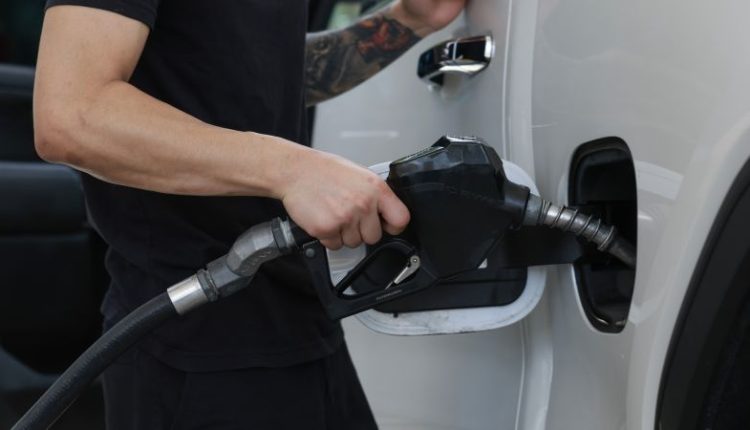Exactly two years ago Friday, gasoline prices peaked at a record of $5.02 a gallon nationally.
The gas spike of 2022 crushed consumer confidence, spooked investors and put a hole in family budgets. It helped propel the national inflation rate to 9% for the first time since the early 1980s.
“Five-dollar gas sent shockwaves through the system. No American outside of California had ever seen five-dollar gas before,” said Patrick De Haan, head of petroleum analysis at GasBuddy.
Gas prices today are not cheap – but they are miles away from that point.
The national average for regular gas stood at $3.46 a gallon on Thursday, according to AAA. Not only is that down $1.56 from the record set in June 2022, it’s down 13 cents from this point last year.
“We’ve come a long way. We’re in a much healthier and balanced market than two years ago,” said De Haan.
Of course, gas prices were cheaper during the Covid-19 pandemic because demand was severely low. Even in June 2021, the national average was a bit lower, at about $3.08 a gallon.
Gas prices peaked this spring at $3.68 a gallon on April 19. The fact that prices have moved steadily lower since then has helped take pressure off cash-strapped consumers.
Cooler gas prices have also played a central role in helping to drive down inflation.
The Bureau of Labor Statistics said this week that monthly consumer prices were unchanged between April and May for the first time in nearly two years. One of the biggest catalysts was the fact that prices at the pump have become cheaper.
Easing inflation has kept alive hopes that the Federal Reserve will be able to start cutting interest rates at least once before the end of the year. That, in turn, would give borrowers a break from historically high rates on mortgages, credit cards and car loans.
There could be political implications, too. In part because they are so visible, gas prices play a key psychological role in how people feel about the economy.
It’s not clear if voters will — or even should — credit the White House for falling gas prices. However, a spike to $4 would likely have negative consequences for President Joe Biden’s reelection campaign, since it would feed concerns about the high cost of living and further dent relatively low consumer confidence.
“Gas prices are so central to how people think about their financial situation. They are the single most important variable in terms of how people are doing — especially low-income households,” said Mark Zandi, chief economist at Moody’s Analytics.
Drivers in some states are paying much less than a year ago for gasoline, including Utah (69 cents), Washington (47 cents) and Idaho (38 cents). There are also significant 12-month price drops in some key battleground states such as Arizona (59 cents), Wisconsin (33 cents) and Nevada (24 cents), according to AAA.
“As the summer driving season continues, Americans are seeing gas prices drop around the country,” White House spokesperson Angelo Fernández Hernández told CNN in a statement. “But there is more work to be done — the President remains committed to lowering prices at the pump for Americans and maintaining a stable and secure energy supply.”
Many people may wish for the $2 gas prices of last decade. Of course, people are making more money than they were a decade ago, so it’s not a fair comparison.
Yet, on an inflation-adjusted basis, gas prices are right in line with where they were before Covid.
Real (inflation-adjusted) gas prices stood at $3.34 a gallon in June 2019 and $3.61 in June 2018, according to the US Energy Information Administration. The current national average of $3.46 is in the middle of that.
Although the White House spokesperson noted “historic investments” in clean energy, he also acknowledged that “record domestic oil and gas production is helping to meet our immediate needs.”
Indeed, even though the oil industry frequently battles with the White House over regulation, US oil output is off the charts.
Powered by the shale oil boom, the United States produced 13.2 million barrels of crude oil per day in March, according to federal statistics. That’s just shy of the record 13.3 million in November.
“Just think about where gasoline prices would be without US shale,” said Rob Thummel, senior portfolio manager at energy investment firm Tortoise.
Oil prices are higher than at this point last year, in part because OPEC+ continues to restrain production. That also reflects concerns about both the war in Ukraine and the Israel-Gaza war.
Gas prices, however, have been guided lower by improving stockpiles of gasoline.
“It’s all about inventories,” Thummel said. “Inventories are likely headed back to normal levels, which will keep gasoline prices lower throughout the summer driving season. That’s good news for consumers.”
GasBuddy’s De Haan noted that gas prices have been on the low end of what his firm was forecasting for June, in part because fewer people are driving.
If a hurricane or oil price shock is avoided, De Haan said gas prices should remain subdued. (Experts have forecast a hyperactive Atlantic hurricane season this year.)
“It’s a good outcome — dare I say a better-than-expected outcome,” he said.
Read the full article here

